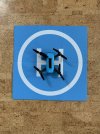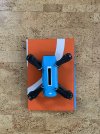dulcificum
Well-Known Member
Please provide evidence of someone getting hurt doing a basic hand landing.Well, where I live, humans sometimes make mistakes, electronics sometimes fail, and the unexpected sometimes happens.
Please provide evidence of someone getting hurt doing a basic hand landing.Well, where I live, humans sometimes make mistakes, electronics sometimes fail, and the unexpected sometimes happens.
9:54, fingers curled, human error. Nobody's perfect.Please provide evidence of someone getting hurt doing a basic hand landing.
Cool, now provide evidence that isn't human error.9:54, fingers curled, human error. Nobody's perfect.
Hi Fat Bastard. First, as I've said several times already, I've hand caught our P4P+ when necessary. And I also know - having established and managed a medical clinic for 25 years - that, in general, so-called freak accidents are much more common that the layman realises. (This has been supported by a couple of distressing stories above with major implications that last decades.) We're outstandingly successful in all that we do simply because we think a lot about all of the psychology factors - which includes eliminating or reducing all kinds of "What if...?" risk. Those who plan are overall much "luckier" than those who don't.Have to ask: Why use a landing pad when hand-catching is much better in pretty much every circumstance?
Wind gusts for one. You can't really control everything.It doesn't move anywhere you don't tell it to, please explain why that should be an issue.
Cool, the old "moving the goalposts" fallacy.Cool, now provide evidence that isn't human error.


The vast majority of human error can be eliminated, but not all. Humans - at every level of capability - will make mistakes, even if it's occasionally rather than frequently. If you know how to eliminate risk in many areas, you'll happily open yourself to minimal risk on a much higher level because it's part of being the absolute best you can be.Cool, the old "moving the goalposts" fallacy.
I said "...sometimes humans make mistakes..."
You said "... provide evidence of someone getting hurt..."
I did.
Moving the goalposts - Wikipedia
en.wikipedia.org
I'm not sure why you're quoting me here, I'm the one who suggested that some people don't want spinning blades near their hands and face. I'm one of them.The vast majority of human error can be eliminated, but not all. Humans - at every level of capability - will make mistakes, even if it's occasionally rather than frequently. If you know how to eliminate risk in many areas, you'll happily open yourself to minimal risk on a much higher level because it's part of being the absolute best you can be.
We've already had a retired ophthalmologist above add his expertise, as eyes are especially vulnerable to injury. I've added mine from a wider medical perspective, based on 25 years clinical experience concerning the frequency of freak injuries. If there's a fireman on this forum, he or she will know just how often a house fire is started by an electrical appliance (switched on or off) plugged into a wall socket. The same fireman will likely be far more cautious in his or her own home, unplugging most devices when going out, knowing the actual reality of risk likelihood. Ignorance changes the perception of reality, to our detriment or even peril. Usually this ignorance or inability to fully face reality shows up as dysfunctional behaviour - which almost all gloss over and normalise, rather than understanding how much of life they miss out on - but sometimes there are physical consequences.
I provided first-person testimony of my own injury in post #34 of this thread. It has healed up with no permanent damage.Please provide evidence of someone getting hurt doing a basic hand landing.
I have flown my P3S in temps as cold as -25C and below. I know wind chill doesn’t affect the drone but it does me, so if it’s windy out I don’t only have to worry about my hands but also frost bite. A good landing pad is almost a necessity in these conditions. I don’t like flying with gloves on as I feel they restrict my fine control. In these cases I use my transmitter glove which covers my hands and controller. My hands still get cold but at least they are not as exposed to wind. A landing mat is a necessity in these conditions and for me hand catching unless absolutely necessary is out of the question.Hi Chris. It's great to know that there's a similar pad available to the Moment one.
I couldn't agree more about cold weather. We're British and just over a year ago we were working in Utah, USA, just as winter hit. One morning, at sunrise, we were flying/filming with the P4P+. The air temperature was -10C (which is 14F), but a severe wind chill on top of that made it an unpleasant situation. I operate the controller bare handed, simply because we need the best results because it's work. I've previously worked in temperatures as low as -40C, but that early morning in Utah was an accident-waiting-to-happen if I had attempted to hand catch. The effects of cold, including hyperthermia, creep up on someone gradually, so you can easily misjudge reduced effectiveness. We're tough, but we were working at the extremes of our tolerance for weeks during that assignment.
I was supporting you.I'm not sure why you're quoting me here, I'm the one who suggested that some people don't want spinning blades near their hands and face. I'm one of them.
I occasionally use my drone to make money but if someone offered me a job where I had to launch or land with my hands, I would politely decline.
I'm not saying anyone should or shouldn't do it. My original post in this thread was in response to people who suggest that hand catching is the best way and how they can't even conceive that something could go wrong.
Oh, I thought you were trying to get me to "... happily open [myself] to minimal risk..."I was supporting you.
Or riding in a metal tube thousands of feet in the air at several hundred miles an hour with no propeller!It always amazes me that people who hand catch their drone can't can't even imagine why someone wouldn't want blades spinning a few thousand RPM within inches of their fingers and within an arm length of their face.
Or riding in a metal tube thousands of feet in the air at several hundred miles an hour with no propeller!
Some people won't do that either.Or riding in a metal tube thousands of feet in the air at several hundred miles an hour with no propeller!
All this being said about hand catching, I do it 99% of the time... but I have made an error, once, and it hurt like heck. Very slight slice of the finger, but mainly the impact on my cold fingers The incident certainly made me be even more careful.It doesn't move anywhere you don't tell it to, please explain why that should be an issue.
We use essential cookies to make this site work, and optional cookies to enhance your experience.

